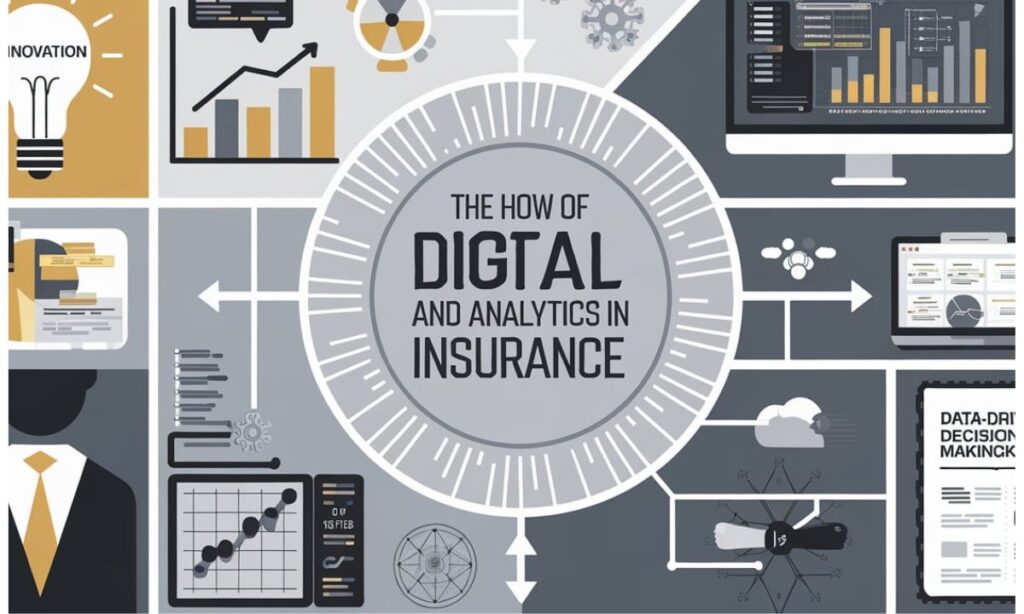Digital tools and data analytics are transforming the insurance industry by improving efficiency, decision-making, and customer experiences. Insurers now rely on technologies like Artificial Intelligence (AI), Machine Learning (ML), and predictive analytics to streamline processes and reduce cost.
. These tools allow insurance companies to assess risks more accurately, automate underwriting, and speed up claims processing.
The Role of Data in Insurance Transformation
Data is the driving force behind insurance transformation. Insurance companies are now collecting and analyzing massive amounts of data. This data comes from customer interactions, IoT devices, and historical records.
With the help of predictive analytics, insurers can identify trends and risks early. For example, claims data can forecast potential future claims. This improves decision-making and allows companies to optimize their services.
Benefits of Data Transformation in Insurance:
| Key Areas | Impact |
| Risk Assessment | Accurate risk predictions |
| Claims Management | Faster claims processing |
| Customer Personalization | Tailored policies for customers |
| Pricing Optimization | Competitive and flexible pricing |
Insurance companies that use big data gain a significant competitive edge. Real-time analysis helps them improve operations and enhance customer satisfaction.
Case Study Example: A major insurance provider used predictive analytics to analyze past claims data. By identifying high-risk policyholders, they reduced overall claims payouts by 20% in a single year.
Additionally, insurers are using data-driven insurance insights to monitor policyholder behavior. For instance, customer data from connected devices (IoT) enables real-time risk assessment and accurate pricing.
How Digital Tools Are Changing Insurance Operations

Digital tools are transforming the way insurers operate. Processes that were once manual and time-consuming are now automated.
Key Examples:
- Automated Claims Processing – Digital platforms speed up claims approval.
- Mobile Insurance Applications – Customers can file claims or access policies using apps.
- Digital Customer Engagement – Tools like chatbots offer 24/7 support.
- AI in Underwriting – AI tools quickly evaluate risk and determine pricing.
These innovations reduce operational costs and improve efficiency. AI in underwriting helps insurers assess risks faster and more accurately. The use of digital tools streamlines processes, ensuring quicker service for customers.
Operational Efficiency Benefits:
| Process | Impact |
| Claims Processing | Reduced turnaround times |
| Customer Support | Faster query resolution |
| Underwriting | Improved accuracy and speed |
| Policy Management | Real-time updates and adjustments |
Digital tools also play a key role in insurance pricing optimization, ensuring that customers receive fair and competitive premiums based on their unique profiles.
AI and Machine Learning: Enhancing Insurance Decision-Making
Artificial Intelligence (AI) and Machine Learning (ML) are game-changers in the insurance sector. These technologies analyze data, automate decisions, and improve outcomes.
How AI Enhances Decision-Making:
- Underwriting Automation Tools: AI simplifies risk assessment by analyzing customer data.
- AI-Powered Insurance Models: Machine learning models predict customer behavior and claims trends.
- Fraud Prevention Technologies: AI identifies suspicious claims patterns to reduce fraud.
- Risk Management with Analytics: AI forecasts risks and enables proactive planning.
For example, ML algorithms help insurers identify customers likely to file a claim. This allows better risk management and pricing optimization. AI not only improves decisions but also reduces human error.
Example of AI Impact: An insurance company implemented AI tools in underwriting. As a result, their underwriting process was 30% faster, improving overall customer satisfaction.
Additionally, insurers use AI for real-time claims processing, minimizing delays and ensuring quick payouts to policyholders.
Digital and Analytics for Fraud Detection

Fraud costs the insurance industry billions every year. Digital tools and analytics are helping to fight this issue effectively.
Techniques for Fraud Detection:
- Advanced Claims Analytics: Analyzes historical claims to spot patterns.
- AI Algorithms for Insurance: Detect anomalies in real-time claims data.
- Machine Learning in Insurance: Flags suspicious activities automatically.
- Fraud Prevention Technologies: Provides real-time fraud alerts to insurers.
By using these tools, insurers can identify fraud before it causes damage. Analytics-driven fraud detection ensures faster claim approvals for genuine customers.
Impact of Fraud Detection Tools:
| Fraud Type | Detection Method |
| False Claims | AI algorithms, pattern analysis |
| Policy Misrepresentation | Data analytics, document scans |
| Organized Fraud Rings | Cross-claim machine learning |
Fraud prevention tools protect insurers from losses and help keep premiums affordable. For example, pattern analysis detects repeated suspicious behaviors across multiple claims.
Customer-Centric Insurance Models Powered by Analytics
The insurance industry is shifting towards a customer-centric approach. Data analytics plays a vital role in understanding customer needs and preferences.
How Analytics Powers Customer-Centric Models:
- Personalized Insurance Policies: Insurers offer tailored coverage based on data insights.
- Real-Time Claims Processing: Customers get faster approvals, improving satisfaction.
- Customer Retention in Insurance: Analytics predicts which customers may leave and offers solutions to retain them.
IoT in insurance analytics enables insurers to track real-time data. For instance, smart devices can monitor vehicle usage for personalized car insurance. These innovations create a better customer experience.
Customer Experience Benefits:
| Focus Area | Outcome |
| Tailored Policies | Higher customer satisfaction |
| Faster Claims | Improved customer trust |
| Real-Time Engagement | Better service delivery |
Example: An insurer used data analytics to offer dynamic pricing for vehicle insurance. Customers who drove less paid lower premiums, improving loyalty.
Challenges in Implementing Digital Transformation
Despite its advantages, implementing digital transformation in insurance comes with challenges.
Common Challenges:
- Data Integration Issues: Combining old systems with new tools can be complex.
- Cybersecurity Risks: Large amounts of data need strong security protocols.
- High Initial Costs: Implementing AI and digital tools requires significant investment.
- Staff Training: Employees need training to adapt to new technologies.
To succeed, insurers must address these obstacles strategically, balancing costs with long-term benefits.
Future of Digital and Analytics in Insurance
The future of insurance lies in the continued evolution of digital tools and analytics.
Upcoming Trends:
- IoT and Smart Devices: Greater integration for real-time analytics.
- AI-Powered Risk Management: Enhanced predictive analytics for accurate decision-making.
- Blockchain Technology: Improved data security and transparency in policies.
- Advanced Mobile Applications: More convenient customer access to insurance services.
By adopting these trends, insurers will become more efficient, secure, and customer-focused. Real-time data insights will revolutionize risk assessment and improve service delivery.
FAQs
1. What is the role of data in digital insurance?
Data helps insurers improve risk management, optimize pricing, and personalize customer experiences.
2. How does AI improve fraud detection?
AI uses algorithms to identify patterns and anomalies in claims data, making fraud detection faster and more accurate.
3. What are customer-centric insurance models?
These models focus on understanding and meeting individual customer needs using analytics and data insights.
4. How do digital tools streamline insurance operations?
Digital tools automate tasks like claims processing and underwriting, reducing time and costs.
5. What is the future of digital transformation in insurance?
The future includes more AI adoption, predictive analytics, IoT integration, and advanced fraud detection tools.
Conclusion
The how of digital and analytics in insurance revolves around data, AI, and advanced tools. These technologies are transforming underwriting, claims processing, fraud detection, and customer engagement. Insurers are now more efficient, agile, and customer-focused.
By adopting predictive analytics, big data, and AI-powered models, the industry is better equipped to meet modern challenges. Digital transformation ensures faster services, personalized policies, and a better customer experience.
The future of insurance lies in leveraging analytics to innovate and grow. Insurers embracing digital tools today will lead the market tomorrow. Those who invest in digital transformation will create smarter, more customer-centric, and competitive insurance solutions.
Read more information https://techyspirtz.com/
Visit my other wesite https://verbvictories.online/

David is a seasoned SEO expert with a passion for content writing, keyword research, and web development. He combines technical expertise with creative strategies to deliver exceptional digital solutions.












 Suspect Arrested in Arson Fire at Pennsylvania Governor’s Home
Suspect Arrested in Arson Fire at Pennsylvania Governor’s Home

